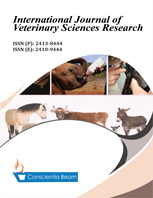Two-Shots of Immunization Effectively Induce Protective IgG against Canine Parvo-Viral Infection
DOI:
https://doi.org/10.18488/ijvsr.v7i2.3200Abstract
Regardless of good hygiene and management, a significant number of dogs are lost every year due to deadly attack of parvo virus. The immunization schedules recommended by the World Small Animal Veterinary Association (WSAVA) do not have exclusive suggestions on dogs living in Bangladesh. The WSAVA Vaccination Guidelines Group (VGG) suggested that vaccination recommendations that apply to a developed country may not be appropriate for a developing country. Due to inadequate sero-monitoring, emergence and re-emergence of Parvo viral infection following immunization is a common event. Therefore, the current study is designed to establish a definite guideline for Parvo viral immunization in dogs. We immunized group of dogs with commercially available parvo virus vaccine Nobivac Dog®, and a second dose was injected 14-days following the initial dose. Sera samples were collected before starting injections and 7-day following 1st and 2nd dose of vaccinations. We performed Enzyme Linked Immunosorbent Assay (ELISA) to detect protective serum IgG titer against the canine parvo virus type 2 antigen. Demographic data of the participated animals was compared to the status of antibody titer. Findings of this study revealed that two-shots of immunizations with a booster injection of 2-3 weeks apart from the primary immunization is essential to develop positive titer. The purebred female dogs of older than three-months had higher IgG when compared to local, crossbred, male and younger dogs. The results will provide valuable information to establish National Guidelines for Immunizations in Dogs of Bangladesh for effective prevention and control of this deadly disease.

